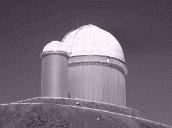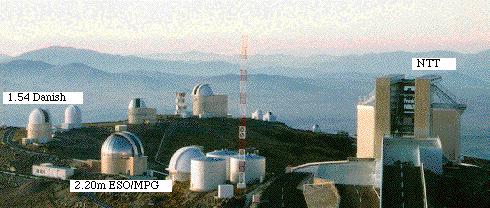



Next: The
MMT and Up: The
recent evolution Previous: The
recent evolution
Classical domes
The classical external shape for a telescope has been for a long time
a cylinder topped by a rotating hemispherical dome, which has a slit made
such that it can have at any time only the opening strictly required for
the view of the telescope. It is interesting to note that this concept
was purely based on the intuition that a curved external shape would create
less turbulence and therefore limit local seeing. The phenomenon of local
seeing was very mysterious and the absence of hard evidence on its causes
left dome designers relying on intuitive beliefs, such as that a smooth
laminar air flow on the dome would be most favorable for the observation.
The dimension of the dome was generally oversized with respect to the telescope,
to protect it from wind loads and it was largely believed that any airflow
on the telescope should be avoided. It was also thought that the telescope
should be raised high above the ground level in order not to be affected
by the near ground turbulence of the surface layer. Such ideas, although
they were not quantified experimentally, determined the design of most
existing telescope buildings.
Let us consider for instance the ESO 3.6-m telescope dome at La Silla
(fig.  ).
Its designers believed that they were giving their telescope all best chances
by locating it on the highest peak of the ridge; for good measure they
built a massive 30-meter high tower topped with an oversize spherical dome
(to prevent wind buffeting on the telescope). As a result the whole building
is very impressive and the rotating dome is a particularly fine piece of
heavy steel engineering. But, as in other examples of 4-meter telescope
domes of the same generation, building and dome costed about 60 million
DM (of 20 years ago) and accounted for about 60% of the entire telescope
project cost.
).
Its designers believed that they were giving their telescope all best chances
by locating it on the highest peak of the ridge; for good measure they
built a massive 30-meter high tower topped with an oversize spherical dome
(to prevent wind buffeting on the telescope). As a result the whole building
is very impressive and the rotating dome is a particularly fine piece of
heavy steel engineering. But, as in other examples of 4-meter telescope
domes of the same generation, building and dome costed about 60 million
DM (of 20 years ago) and accounted for about 60% of the entire telescope
project cost.

Figure: The ESO 3.6-m telescope building at La Silla: a 30-m
high cylinder topped by a 30-m diameter hemispherical dome.

Figure: The building of the 2.2-m telescope is not larger than
the ones of many smaller telescopes at La Silla.
Some evidence that something may have been overdone began to appear
a few years later when the ESO-MPG 2.2-m telescope was erected at La Silla.
Its building is much more modest than its large predecessor (fig.  ).
It is also located on a lower location on the main La Silla ridge. The
telescope is placed almost at ground level and the dome fits the telescope
with a minimal clearance. These choices were at the time dictated by financial
budget constraints, nevertheless they did not seem to affect performance:
the 2.2-m telescope was reported to have consistently better seeing than
the 3.6-m ([Pedersen], see also section
).
It is also located on a lower location on the main La Silla ridge. The
telescope is placed almost at ground level and the dome fits the telescope
with a minimal clearance. These choices were at the time dictated by financial
budget constraints, nevertheless they did not seem to affect performance:
the 2.2-m telescope was reported to have consistently better seeing than
the 3.6-m ([Pedersen], see also section  hereafter). While a proper comparison should assess in particular the different
thermal designs
hereafter). While a proper comparison should assess in particular the different
thermal designs of the two buildings, it is quite obvious that there was an evident disproportion
in the 3.6-m dome between means employed and results achieved.
of the two buildings, it is quite obvious that there was an evident disproportion
in the 3.6-m dome between means employed and results achieved.




Next: The
MMT and Up: The
recent evolution Previous: The
recent evolution
Lorenzo Zago, lorenzo.zago@heig-vd.ch, Mon Nov 6 23:33:14 GMT+0100 1995
 ).
Its designers believed that they were giving their telescope all best chances
by locating it on the highest peak of the ridge; for good measure they
built a massive 30-meter high tower topped with an oversize spherical dome
(to prevent wind buffeting on the telescope). As a result the whole building
is very impressive and the rotating dome is a particularly fine piece of
heavy steel engineering. But, as in other examples of 4-meter telescope
domes of the same generation, building and dome costed about 60 million
DM (of 20 years ago) and accounted for about 60% of the entire telescope
project cost.
).
Its designers believed that they were giving their telescope all best chances
by locating it on the highest peak of the ridge; for good measure they
built a massive 30-meter high tower topped with an oversize spherical dome
(to prevent wind buffeting on the telescope). As a result the whole building
is very impressive and the rotating dome is a particularly fine piece of
heavy steel engineering. But, as in other examples of 4-meter telescope
domes of the same generation, building and dome costed about 60 million
DM (of 20 years ago) and accounted for about 60% of the entire telescope
project cost.






